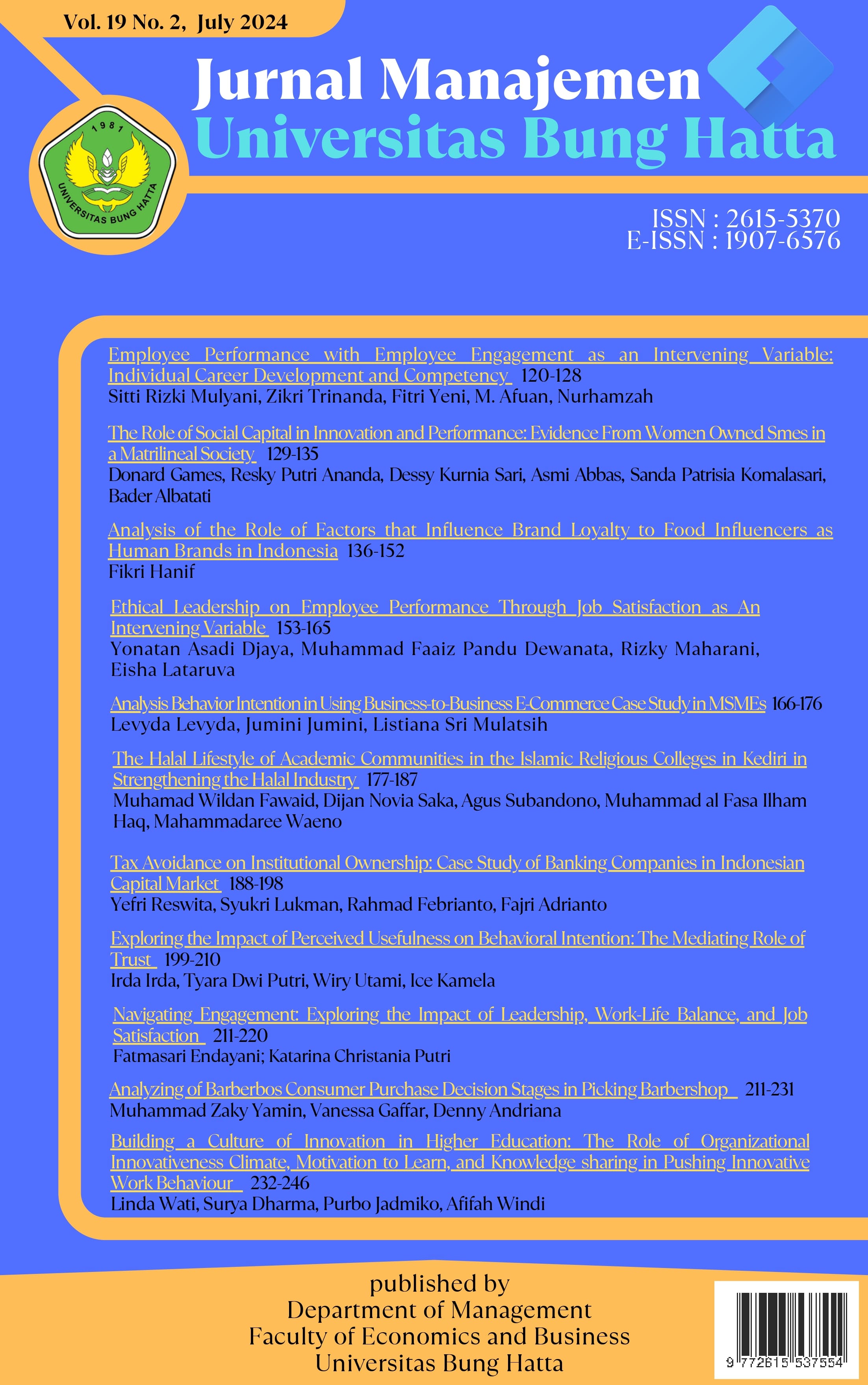Analyzing of Barberbos Consumer Purchase Decision Stages in Picking Barbershop
DOI:
https://doi.org/10.37301/jmubh.v19i2.25541Abstract
This research aims to explore the entire consumer purchasing decision process in choosing Barberbos, from problem recognition to post-purchase. The method used is qualitative with a case study approach, the sample was taken by purposive sampling, namely 23 people who were consumers who had tried Barberbos services. Data collection was carried out using interviews, literature studies, documentation studies, and online search methods, then the data was analyzed using thematic analysis. The research results show that in the first stage, the need and desire to shave one's hair was triggered internally by the source himself, there was no encouragement from other people. Information search stages: sources know Barberbos through location, word of mouth, and social media. At the alternative evaluation stage, only some of the material for consideration by the majority of the interviewees was the results of the shaving, followed by the place, then some said there was no particular reason and there were those who were invited by friends. The reason the interviewee chose Barberbos was because it was famous, the shave results, the service and the place was nice. For the final stage, all interviewees felt very satisfied, satisfied, and quite satisfied with the shave they got.
References
Ani, J., Lumanauw, B., & Tampenawas, J. L. A. (2021). PENGARUH CITRA MEREK, PROMOSI DAN KUALITAS LAYANAN TERHADAP KEPUTUSAN PEMBELIAN KONSUMEN PADA E-COMMERCE TOKOPEDIA DI KOTA MANADO THE INFLUENCE OF BRAND IMAGE, PROMOTION AND SERVICE QUALITY ON CONSUMER PURCHASE DECISIONS ON TOKOPEDIA E-COMMERCE IN MANADO CITY. 663 Jurnal EMBA, 9(2), 663–674.
Arfah, Y. (2022). Keputusan Pembelian Produk. . PT Inovasi Pratama International .
Aslami, N. (2022). Analisis Kebutuhan Perubahan Untuk Meningkatkan Kepuasan Pelanggan (Study Kasus : Vibes Barbershop & Coffee). Jurnal Ilmiah Multidisiplin, 1(8).
Bungin, B. (2007). Penelitian Kualitatif. Kencana Media Group.
Creswell, J. W. (2007). Qualitative Inquiry and Research Design: Choosing among Five Approaches (2nd ed.). SAGE Publications Inc.
Daymon, C., & Holloway, I. (2008). Metode-Metode Riset KualitatifL dalam Public Relations dan Marketing Communication. Pt. Bentang Pustaka.
Dicka Pratama, Y., & Gunady Ony, J. (2020). Analisis Daya Saing UMKM Barbershop di Kota Palembang. In Johan Gunady Ony, JISTIN (Vol. 4, Issue 2).
Emeralda, Wulandari, J., & Adistya, D. (2020). analisis e-trust e-wom dan e-service dalam keputusan pembelian online. Jurnal Perspektif Bisnis, 3(2).
Emzir. (2010). Metodologi Penelitian Kualitatif. Pt. Raja Grafindo Persada.
Fadhli, K., Dwi Aprilia, E., & Angga Putra, I. (2021). Pengaruh Ekuitas Merek Dan Perilaku Konsumen Terhadap Keputusan Pembelian Ulang Produk Minyak Goreng Pada Masa Pandemi Covid-19. Jurnal Manajemen Universitas Bung Hatta, 16(2), 96–104. https://doi.org/10.37301/jmubh.v16i2.19038
Ghufron, M. (2019). pengaruh kualitas layanan dan harga terhadap keputusan menggunakan hairstudio (barbershop). Jurnal Pendidikan Tata Niaga, 7(3).
Hasan, G., & Lim, D. (2021). Menganalisis Efektivitas Ewom Pada Customer Purchase Intention Dengan Menggunakan Social Networking of Smartphone in Batam. Jurnal Manajemen Universitas Bung Hatta, 16(2), 87–95. https://doi.org/10.37301/jmubh.v16i2.19025
J. Setiadi, N. (2010). Perilaku konsumen (4th ed.). Kencana.
Lupiyoadi, H. (2008). Manajemen Pemasaran Jasa (2nd ed.). salemba empat.
Moloeng, L. J. (2000). Metode Penelitian Kualitatif. Pt. Remaja Rosdakarya.
Moloeng, L. J. (2004). Metode Penelitian Kualitatif. Pt. Remaja Rosdakarya.
Mulyana, D. (2003). Metode Penelitian Kualitatif. Pt. Remaja Rosdakarya.
Phillip, K. (2004). Manajemen Pemasaran. salemba empat.
Phillip, K., & G, A. (2007). Dasar-Dasar Pemasaran. Pt.Indeks.
Phillip, K., & G, A. (2018). Marketing Management. Pearson Education.
Prasetyo, B. D. (2018). Komunikasi Pemasaran Terpadu: Pendekatan Tradisional Hingga Era Modern Baru. UB Press.
Ramadhan, J., & Susianto, D. (2019). SISTEM INFORMASI JASA PANGKAS RAMBUT BEBASIS WEB PADA BARBERSHOP BJ DI BANDAR LAMPUNG. Jurnal ONESISMIK, 1(1).
Risti, L. L., & Cahyanti, M. M. (2022). pengaruh diskon dan penilaian produk mie gacoan terhadap keputusan pembelian gofood. Jurnal Distribusi, 10(1).
Roberts, M., & Pettigrew, S. (2007). A thematic content analysis of children’s food advertising. International Journal of Advertising, 26(3), 357–367. https://doi.org/10.1080/02650487.2007.11073018
Sernovitz, A. (2009). Word of Mouth Marketing: How Smart Companies get People Talking. Kaplan Publishing.
Sherihulla Mokoagow STIE Widya Darma Kotamobagu, S. (2022). ANALISA PEMASARAN JASA TUKANG CUKUR PADA BARBER SHOP SULTAN DI KELURAHAN MOLINOW KECAMATAN KOTAMOBAGU BARAT. Journal, 1(3), 263–272.
Solomon, M. R. (2018). Consumer Behavior: Buying, Having, and Being. Pearson Education.
Sugiyono, P. D. (2013). Penelitian Kualitatif. Alfabeta.
Supranto, J., & Limakrisna, N. (2011). Perilaku Konsumen & Strategi Pemasaran; Untuk Memenangkan Persaingan Bisnis. Mitra Wacana Media.
Suryadi, E., Kusnendi, & Mulyadi, A. (2020). Metode Penelitian Manajemen. UPI Press.
Takaeb, M. Z., & Kelen, L. K. S. (2021). analisis kelayakan investasi pada usaha barbershop di kabupaten sumba timur. Jurnal Riset Ekonomi, 1(2).
Tjiptono, F. (2014a). Pemasaran Jasa. Andi Yogyakarta.
Tjiptono, F. (2014b). Strategi Pemasaran. Andi Yogyakarta.
Vaismoradi, M., Turunen, H., & Bondas, T. (2013). Content analysis and thematic analysis: Implications for conducting a qualitative descriptive study. Nursing and Health Sciences, 15(3), 398–405. https://doi.org/10.1111/nhs.12048
Downloads
Published
Issue
Section
License
Copyright (c) 2024 Muhammad Zaky Yamin, Vanessa Gaffar, Denny Andriana

This work is licensed under a Creative Commons Attribution-ShareAlike 4.0 International License.
Authors who publish with Jurnal Manajemen Universitas Bung Hatta agree to the following terms:
- Authors retain copyright and grant the journal right of first publication with the work simultaneously licensed under a Creative Creative Commons Attribution-ShareAlike 4.0 International License that allows others to share the work with an acknowledgement of the work's authorship and initial publication in Jurnal Manajemen Universitas Bung Hatta.
- The author holds the copyright of the submitted and published articles, with the understanding that articles are disseminated under the Creative Commons Attribution-ShareAlike 4.0 International License..
- The editor team is entitled to do the editing in accordance with the guidelines for writing or template in the Jurnal Manajemen Universitas Bung Hatta.
This work is licensed under a Creative Commons Attribution-ShareAlike 4.0 International License.












